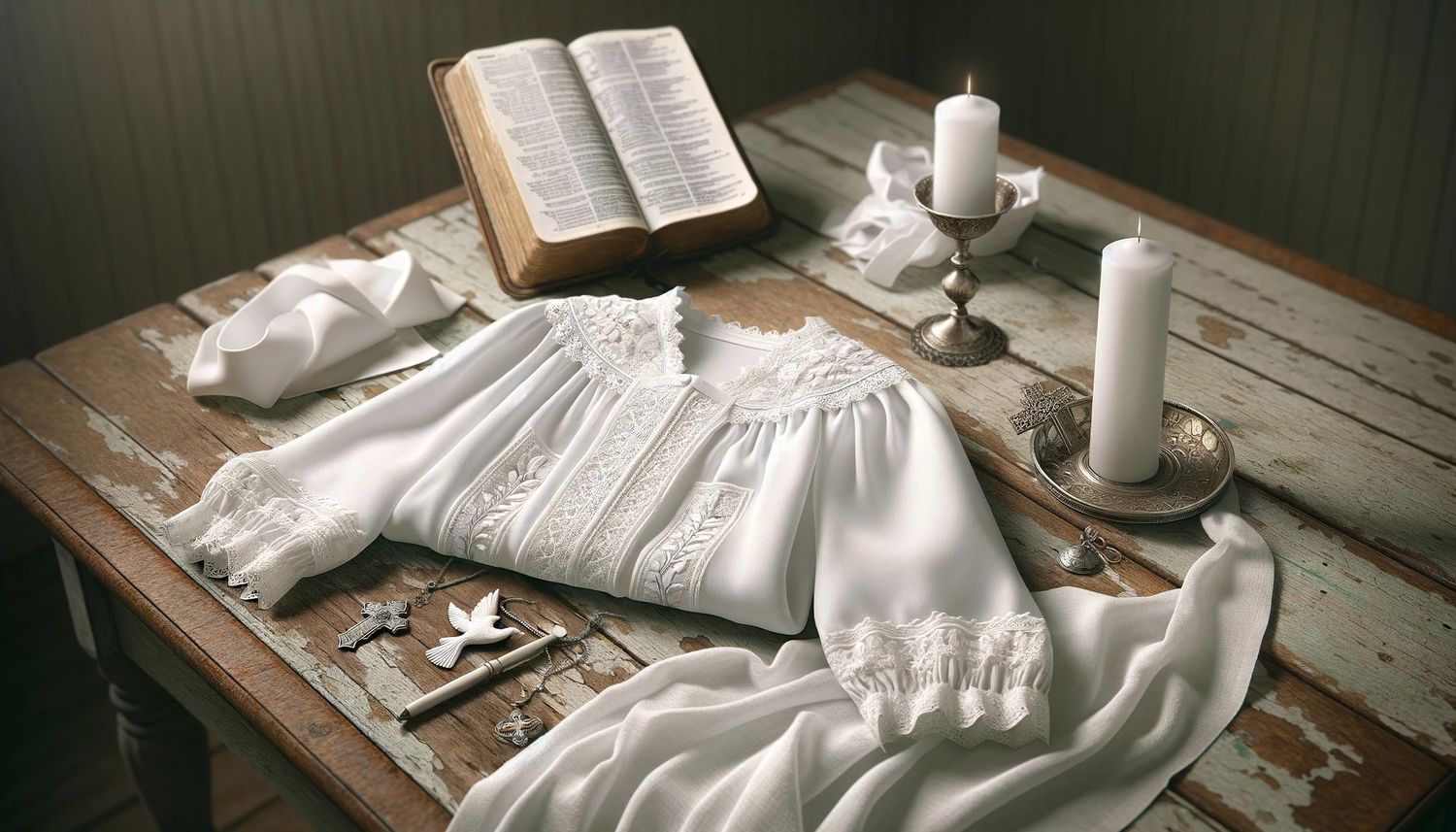Home>Theology and Spirituality>Why Is White Garment Used In Baptism


Theology and Spirituality
Why Is White Garment Used In Baptism
Published: February 29, 2024
Jason DeRose, Managing Editor at Christian.net, uses his expertise in religion and journalism to deepen understanding of faith's societal impacts. His editorial leadership, coupled with a strong academic background, enriches the platform’s diverse content, earning him recognition in both journalism and religious circles.
Discover the significance of white garments in baptism and its symbolism in theology and spirituality. Explore the spiritual meaning behind the use of white attire in this sacred ritual.
(Many of the links in this article redirect to a specific reviewed product. Your purchase of these products through affiliate links helps to generate commission for Christian.net, at no extra cost. Learn more)
Table of Contents
The Symbolism of White Garments in Baptism
White garments hold significant symbolism in the context of baptism. They represent purity, innocence, and the washing away of sins. The act of putting on a white garment during baptism signifies the shedding of the old self and the emergence of a new, cleansed individual. White is often associated with light, goodness, and the divine, making it a fitting choice for this sacred ritual. The white garment serves as a visual representation of the spiritual transformation that occurs during baptism, signifying the individual's commitment to leading a life of righteousness and purity.
-
Purity and Innocence: The white garment worn during baptism symbolizes the purity and innocence of the individual being baptized. It serves as a visual reminder of the cleansing of sin and the rebirth into a life of spiritual purity.
-
Renewal and Rebirth: White garments also symbolize renewal and rebirth. By donning the white garment, the baptized individual signifies their willingness to leave behind their old ways and embrace a new life guided by faith and righteousness.
-
Spiritual Cleansing: The act of wearing a white garment during baptism represents the spiritual cleansing that takes place. It signifies the washing away of sin and the forgiveness of past transgressions, allowing the individual to start afresh in their spiritual journey.
-
Connection to the Divine: White is often associated with the divine and the presence of God. By wearing a white garment, the baptized individual acknowledges their connection to the divine and their commitment to living a life in accordance with the teachings of their faith.
-
Unity and Equality: In some religious traditions, the use of white garments in baptism also symbolizes the unity and equality of all believers. Regardless of social status or background, the white garment serves as a unifying symbol, emphasizing the shared commitment to faith and spiritual growth.
The symbolism of white garments in baptism extends beyond mere attire; it encapsulates the profound spiritual significance of the ritual, serving as a powerful visual representation of the individual's commitment to their faith and the transformative nature of the baptismal experience.
Read more: Why Wear White For Baptism
Historical Significance of White Garments in Baptism
-
Early Christian Practices: The use of white garments in baptism can be traced back to the early Christian practices. In the early Christian church, baptism was a significant rite of passage, marking the initiation of new members into the faith community. The tradition of wearing white garments during baptism has its roots in the symbolism of purity and spiritual rebirth, reflecting the early Christians' understanding of the transformative nature of the sacrament.
-
Biblical References: The historical significance of white garments in baptism is also linked to biblical references. In the New Testament, the apostle Paul makes references to the concept of being clothed in Christ, emphasizing the spiritual significance of putting on a new, pure identity through baptism. This biblical imagery has influenced the tradition of wearing white garments during the sacrament, highlighting the historical and scriptural foundations of this practice.
-
Early Christian Art and Iconography: The historical significance of white garments in baptism is further evidenced through early Christian art and iconography. Depictions of baptism in early Christian art often feature individuals adorned in white robes, symbolizing the spiritual purity and renewal associated with the sacrament. These artistic representations provide historical insights into the early Christian understanding of baptism and the symbolic use of white garments as a visual expression of the sacrament's transformative power.
-
Cultural and Symbolic Traditions: Beyond the early Christian context, the historical significance of white garments in baptism is also influenced by cultural and symbolic traditions. In various cultures and religious traditions, the color white has long been associated with purity, holiness, and spiritual significance. The incorporation of white garments in baptism reflects the broader cultural and symbolic meanings attributed to the color white, underscoring its historical and cross-cultural significance in the ritual of baptism.
-
Continuity and Tradition: Over the centuries, the historical significance of white garments in baptism has been upheld through continuity and tradition within Christian communities. The practice of donning white garments during baptism has endured as a symbol of the timeless spiritual truths associated with the sacrament, emphasizing the enduring historical significance of this ritual attire in the context of baptism.
The historical significance of white garments in baptism is deeply rooted in early Christian practices, biblical references, artistic representations, cultural symbolism, and the enduring traditions of faith communities. This historical depth adds layers of meaning to the use of white garments in baptism, enriching the sacramental experience with a sense of continuity, tradition, and spiritual significance.
The Practical Considerations of Using White Garments in Baptism
-
Accessibility and Affordability: White garments are often chosen for baptism due to their accessibility and affordability. Unlike elaborate or specific ceremonial attire, white garments can be easily obtained and are relatively inexpensive, making them a practical choice for individuals from diverse socioeconomic backgrounds. This accessibility ensures that all individuals, regardless of their financial means, can participate in the sacrament of baptism without the burden of acquiring specialized attire.
-
Ease of Sizing and Fitting: White garments offer practicality in terms of sizing and fitting. Unlike tailored or intricate garments, white baptismal attire can be easily standardized in various sizes, accommodating individuals of different ages and body types. This ease of sizing and fitting simplifies the logistical aspects of organizing baptismal ceremonies, ensuring that participants can readily obtain and wear the appropriate attire without the need for extensive alterations or customizations.
-
Symbolic Simplicity and Universality: The practical considerations of using white garments in baptism also stem from their symbolic simplicity and universality. White, as a color, transcends cultural and aesthetic differences, carrying a universal symbolism of purity and spiritual significance. By opting for white garments, the practical aspect of universality is addressed, allowing individuals from diverse cultural backgrounds to partake in the sacrament without the constraints of specific cultural or traditional attire.
-
Ease of Maintenance and Care: White garments are often chosen for baptism due to their ease of maintenance and care. Unlike intricate or ornate attire, white baptismal garments can be laundered and maintained with minimal effort, ensuring that they remain pristine and presentable for future use. This practical consideration aligns with the symbolic significance of purity, as the white garments symbolize the spiritual cleanliness and renewal experienced through baptism.
-
Adaptability to Various Baptismal Settings: White garments offer practical adaptability to various baptismal settings. Whether the sacrament takes place in a church, a natural body of water, or another location, white attire seamlessly integrates with the diverse settings where baptism ceremonies occur. This adaptability simplifies the logistical aspects of organizing baptismal rites, allowing for a seamless and practical approach to the attire worn during the sacrament.
The practical considerations of using white garments in baptism encompass accessibility, affordability, ease of sizing and fitting, symbolic universality, ease of maintenance, and adaptability to diverse settings. These practical aspects ensure that the attire worn during baptism aligns with the inclusive and transformative nature of the sacrament, allowing individuals to participate in this sacred ritual with practicality and symbolic significance.
The Spiritual Meaning Behind White Garments in Baptism
The spiritual meaning behind white garments in baptism delves into the profound symbolism and significance attributed to the act of donning white attire during this sacred ritual. It encompasses the spiritual journey of the baptized individual, the transformative power of the sacrament, and the symbolic representation of spiritual purity and renewal.
Symbol of Spiritual Cleansing and Purity
The white garment worn during baptism serves as a powerful symbol of spiritual cleansing and purity. It signifies the washing away of sin and the emergence of a cleansed, renewed individual. The act of putting on the white garment represents the shedding of the old self and the embrace of a life guided by spiritual purity and righteousness. This symbolism underscores the transformative nature of baptism, emphasizing the individual's commitment to leading a life free from the burdens of past transgressions.
Read more: Why Is White Worn At First Communion
Emblem of New Life and Rebirth
White garments in baptism also serve as an emblem of new life and rebirth. By adorning the white attire, the baptized individual symbolizes their willingness to leave behind their former ways and embrace a new identity rooted in faith and spiritual renewal. The white garment becomes a visual representation of the individual's journey towards a life guided by the principles of their faith, signifying a profound spiritual rebirth and a commitment to living in accordance with their religious beliefs.
Reflection of Divine Light and Grace
White, as a color, is often associated with light, goodness, and the divine. The white garment worn during baptism reflects the divine light and grace that illuminates the spiritual path of the baptized individual. It symbolizes the presence of God's grace and the guiding light of faith, underscoring the individual's connection to the divine and their commitment to walking in the path of righteousness. The white attire becomes a tangible expression of the divine presence and the transformative power of God's grace in the life of the baptized individual.
Sign of Commitment to Faith
The act of wearing a white garment during baptism signifies the individual's commitment to their faith and spiritual growth. It serves as a visible declaration of the individual's dedication to living a life aligned with the teachings and principles of their religious tradition. The white attire becomes a symbol of the baptized individual's pledge to uphold the values of their faith, embodying their commitment to spiritual development, moral integrity, and a life guided by the tenets of their religious beliefs.
Expression of Unity and Communal Identity
In some religious traditions, the use of white garments in baptism also expresses unity and communal identity. The white attire symbolizes the shared commitment of believers to their faith, transcending individual differences and backgrounds. It becomes a unifying symbol, emphasizing the collective journey of spiritual growth and the communal identity of the faith community. The white garment worn during baptism thus becomes a visual representation of the interconnectedness and shared spiritual aspirations of the community of believers.
The spiritual meaning behind white garments in baptism encompasses the profound symbolism of spiritual cleansing, new life, divine grace, commitment to faith, and communal unity. It underscores the transformative and communal nature of the sacrament, enriching the baptismal experience with layers of spiritual significance and symbolic depth.














